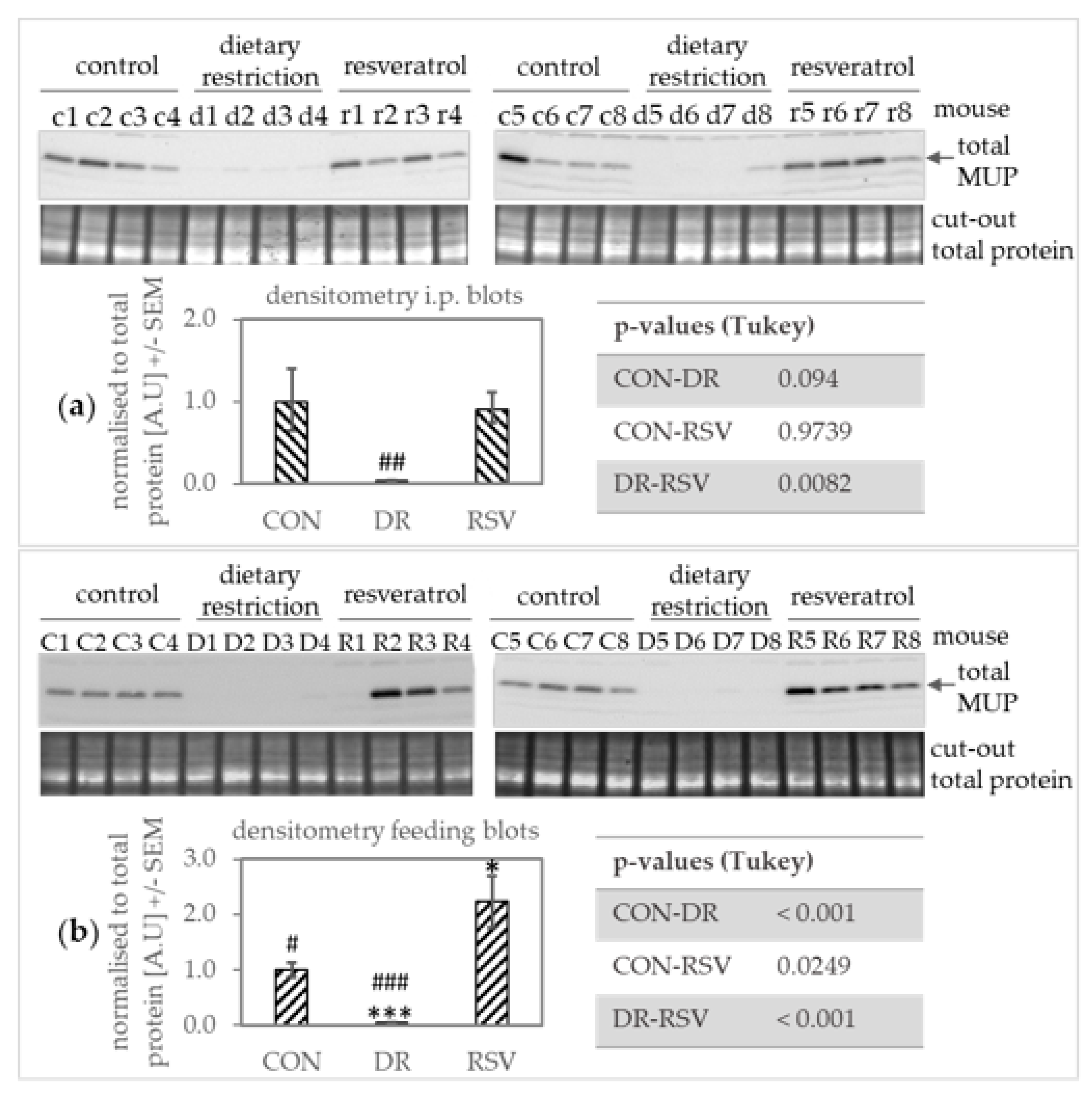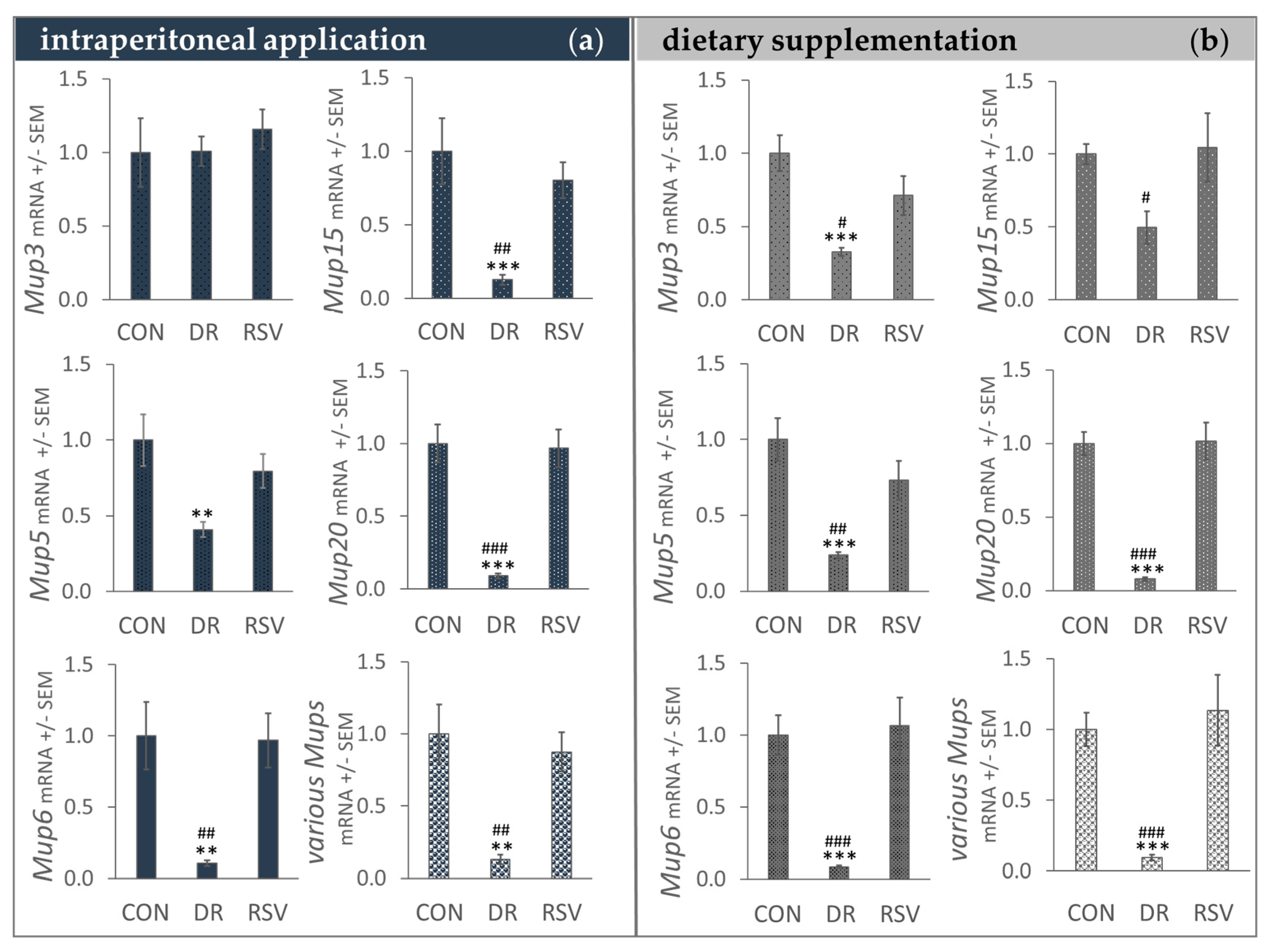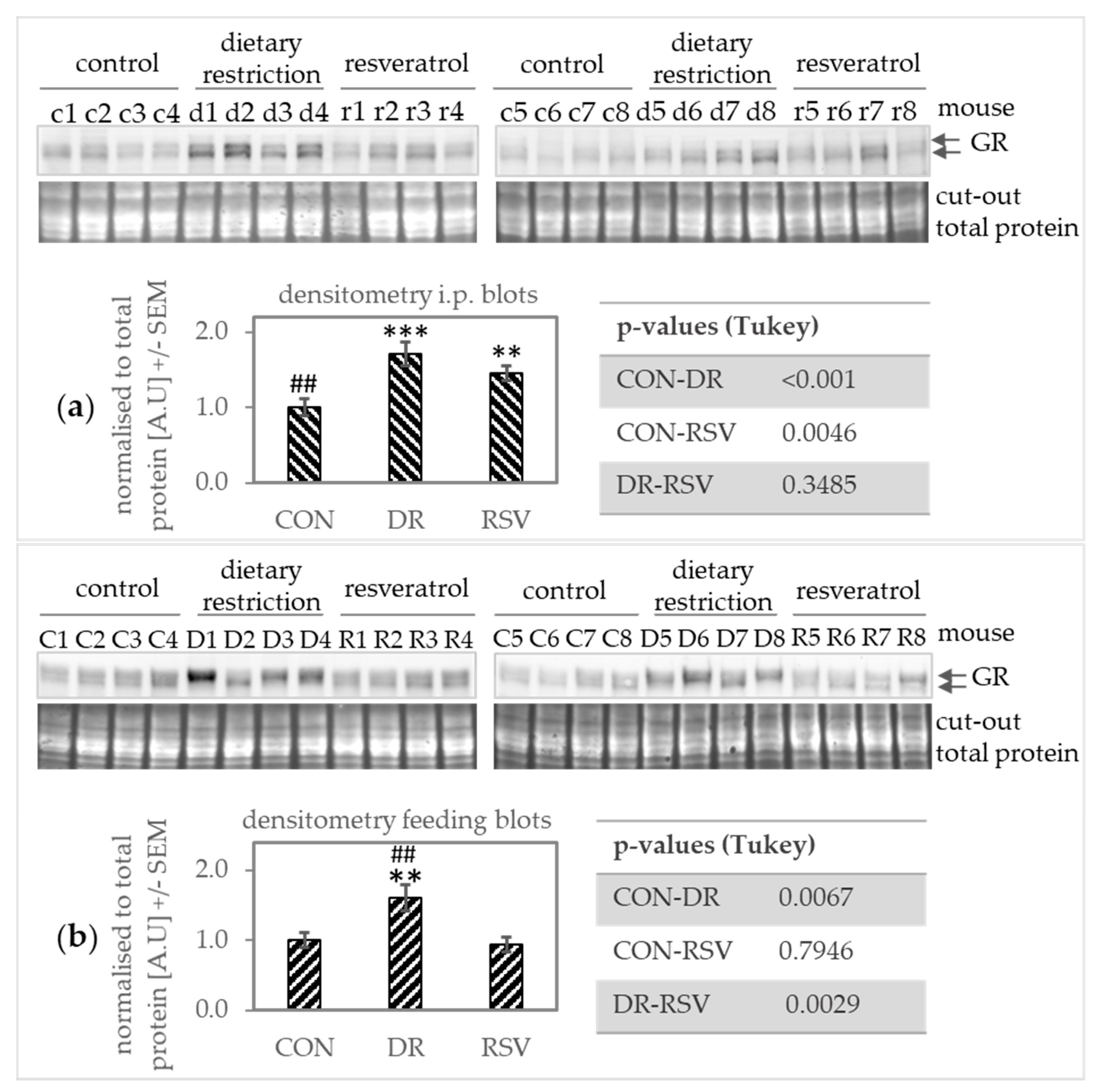In Contrast to Dietary Restriction, Application of Resveratrol in Mice Does not Alter Mouse Major Urinary Protein Expression
Abstract
1. Introduction
2. Materials and Methods
2.1. Mice, Diet, and Intraperitoneal Injections
2.2. RNA Isolation and Quantitative Real-Time Polymerase Chain Reaction (qRT-PCR)
2.3. Western Blotting
2.4. Statistics
3. Results
3.1. Food Intake and BW Do Not Differ Between Non-supplemented and RSV-Supplemented Mice
3.2. Compared to a Considerable MUP Protein Level Decrease in CR Mice, MUP Levels between RSV Mice and the AL Control Appear Similar
3.3. Mup mRNA Levels Seem Unaffected by RSV Supplementation but are Decreased by DR
3.4. Translocation of the Glucocorticoid Receptor into the Nucleus May be Increased Under DR but not RSV Supplementation
4. Discussion
5. Conclusions
Supplementary Materials
Author Contributions
Funding
Acknowledgments
Conflicts of Interest
References
- Szoka, P.R.; Gallagher, J.F.; Held, W.A. In Vitro synthesis and characterization of precursors to the mouse major urinary proteins. J. Biol. Chem. 1980, 255, 1367–1373. [Google Scholar]
- Flower, D.R. The lipocalin protein family: Structure and function. Biochem. J. 1996, 318 Pt 1, 1–14. [Google Scholar] [CrossRef]
- Hurst, J.L.; Robertson, D.H.L.; Tolladay, U.; Beynon, R.J. Proteins in urine scent marks of male house mice extend the longevity of olfactory signals. Anim. Behav. 1998, 55, 1289–1297. [Google Scholar] [CrossRef] [PubMed]
- Chamero, P.; Marton, T.F.; Logan, D.W.; Flanagan, K.; Cruz, J.R.; Saghatelian, A.; Cravatt, B.F.; Stowers, L. Identification of protein pheromones that promote aggressive behaviour. Nature 2007, 450, 899–902. [Google Scholar] [CrossRef] [PubMed]
- Kaur, A.W.; Ackels, T.; Kuo, T.H.; Cichy, A.; Dey, S.; Hays, C.; Kateri, M.; Logan, D.W.; Marton, T.F.; Spehr, M.; et al. Murine pheromone proteins constitute a context-dependent combinatorial code governing multiple social behaviors. Cell 2014, 157, 676–688. [Google Scholar] [CrossRef] [PubMed]
- Szoka, P.R.; Paigen, K. Regulation of mouse major urinary protein production by the mup-a gene. Genetics 1978, 90, 597–612. [Google Scholar] [PubMed]
- More, L. Mouse major urinary proteins trigger ovulation via the vomeronasal organ. Chem. Senses 2006, 31, 393–401. [Google Scholar] [CrossRef][Green Version]
- Mucignat-Caretta, C.; Caretta, A.; Cavaggioni, A. Acceleration of puberty onset in female mice by male urinary proteins. J. Physiol. 1995, 486 Pt 2, 517–522. [Google Scholar] [CrossRef]
- Logan, D.W.; Marton, T.F.; Stowers, L. Species specificity in major urinary proteins by parallel evolution. PLoS ONE 2008, 3, e3280. [Google Scholar] [CrossRef]
- Cheetham, S.A.; Smith, A.L.; Armstrong, S.D.; Beynon, R.J.; Hurst, J.L. Limited variation in the major urinary proteins of laboratory mice. Physiol. Behav. 2009, 96, 253–261. [Google Scholar] [CrossRef]
- Janotova, K.; Stopka, P. The level of major urinary proteins is socially regulated in wild mus musculus musculus. J. Chem. Ecol. 2011, 37, 647–656. [Google Scholar] [CrossRef] [PubMed]
- Dhahbi, J.M.; Kim, H.J.; Mote, P.L.; Beaver, R.J.; Spindler, S.R. Temporal linkage between the phenotypic and genomic responses to caloric restriction. Proc. Natl. Acad. Sci. USA 2004, 101, 5524–5529. [Google Scholar] [CrossRef] [PubMed]
- Giller, K.; Huebbe, P.; Doering, F.; Pallauf, K.; Rimbach, G. Major urinary protein 5, a scent communication protein, is regulated by dietary restriction and subsequent re-feeding in mice. Proc. Biol. Sci. 2013, 280, 20130101. [Google Scholar] [CrossRef] [PubMed]
- Miller, R.A.; Chang, Y.; Galecki, A.T.; Al-Regaiey, K.; Kopchick, J.J.; Bartke, A. Gene expression patterns in calorically restricted mice: Partial overlap with long-lived mutant mice. Mol. Endocrinol. 2002, 16, 2657–2666. [Google Scholar] [CrossRef]
- Van Schothorst, E.M.; Keijer, J.; Pennings, J.L.; Opperhuizen, A.; van den Brom, C.E.; Kohl, T.; Franssen-van Hal, N.L.; Hoebee, B. Adipose gene expression response of lean and obese mice to short-term dietary restriction. Obesity 2006, 14, 974–979. [Google Scholar] [CrossRef]
- De Giorgio, M.R.; Yoshioka, M.; St-Amand, J. Feeding induced changes in the hypothalamic transcriptome. Clin. Chim. Acta Int. J. Clin. Chem. 2009, 406, 103–107. [Google Scholar] [CrossRef]
- Hui, X.; Zhu, W.; Wang, Y.; Lam, K.S.; Zhang, J.; Wu, D.; Kraegen, E.W.; Li, Y.; Xu, A. Major urinary protein-1 increases energy expenditure and improves glucose intolerance through enhancing mitochondrial function in skeletal muscle of diabetic mice. J. Biol. Chem. 2009, 284, 14050–14057. [Google Scholar] [CrossRef]
- Wu, Y.; Kim, J.Y.; Zhou, S.; Smas, C.M. Differential screening identifies transcripts with depot-dependent expression in white adipose tissues. BMC Genom. 2008, 9, 397. [Google Scholar] [CrossRef]
- Fontana, L.; Partridge, L.; Longo, V.D. Extending healthy life span—From yeast to humans. Science 2010, 328, 321–326. [Google Scholar] [CrossRef]
- Ades, P.A.; Savage, P.D. Obesity in coronary heart disease: An unaddressed behavioral risk factor. Prev. Med. 2017, 104, 117–119. [Google Scholar] [CrossRef]
- De Oliveira, C.M.; Pavani, J.; Krieger, J.E.; de Oliveira Alvim, R.; Mourao-Junior, C.A.; da Costa Pereira, A. Body adiposity index in assessing the risk of type 2 diabetes mellitus development: The baependi heart study. Diabetol. Metab. Syndr. 2019, 11, 76. [Google Scholar] [CrossRef] [PubMed]
- Ford, E.S.; Giles, W.H.; Dietz, W.H. Prevalence of the metabolic syndrome among us adults: Findings from the third national health and nutrition examination survey. JAMA 2002, 287, 356–359. [Google Scholar] [CrossRef]
- Giller, K.; Huebbe, P.; Hennig, S.; Dose, J.; Pallauf, K.; Doering, F.; Rimbach, G. Beneficial effects of a 6-month dietary restriction are time-dependently abolished within 2 weeks or 6 months of refeeding-genome-wide transcriptome analysis in mouse liver. Free Radic. Biol. Med. 2013, 61, 170–178. [Google Scholar] [CrossRef] [PubMed]
- Ross, K.M.; Qiu, P.; You, L.; Wing, R.R. Characterizing the pattern of weight loss and regain in adults enrolled in a 12-week internet-based weight management program. Obesity 2018, 26, 318–323. [Google Scholar] [CrossRef] [PubMed]
- Nikolai, S.; Pallauf, K.; Huebbe, P.; Rimbach, G. Energy restriction and potential energy restriction mimetics. Nutr. Res. Rev. 2015, 28, 100–120. [Google Scholar] [CrossRef][Green Version]
- Roth, G.S.; Ingram, D.K. Manipulation of health span and function by dietary caloric restriction mimetics. Ann. N. Y. Acad. Sci. 2016, 1363, 5–10. [Google Scholar] [CrossRef]
- Zamora-Ros, R.; Andres-Lacueva, C.; Lamuela-Raventós, R.M.; Berenguer, T.; Jakszyn, P.; Martínez, C.; Sánchez, M.J.; Navarro, C.; Chirlaque, M.D.; Tormo, M.-J.; et al. Concentrations of resveratrol and derivatives in foods and estimation of dietary intake in a Spanish population: European prospective investigation into cancer and nutrition (epic)-spain cohort. Br. J. Nutr. 2008, 100. [Google Scholar] [CrossRef]
- Baur, J.A.; Pearson, K.J.; Price, N.L.; Jamieson, H.A.; Lerin, C.; Kalra, A.; Prabhu, V.V.; Allard, J.S.; Lopez-Lluch, G.; Lewis, K.; et al. Resveratrol improves health and survival of mice on a high-calorie diet. Nature 2006, 444, 337–342. [Google Scholar] [CrossRef]
- Barger, J.L.; Kayo, T.; Vann, J.M.; Arias, E.B.; Wang, J.; Hacker, T.A.; Wang, Y.; Raederstorff, D.; Morrow, J.D.; Leeuwenburgh, C.; et al. A low dose of dietary resveratrol partially mimics caloric restriction and retards aging parameters in mice. PLoS ONE 2008, 3, e2264. [Google Scholar] [CrossRef]
- Shaw, P.H.; Held, W.A.; Hastie, N.D. The gene family for major urinary proteins: Expression in several secretory tissues of the mouse. Cell 1983, 32, 755–761. [Google Scholar] [CrossRef]
- Nelson, A.C.; Cauceglia, J.W.; Merkley, S.D.; Youngson, N.A.; Oler, A.J.; Nelson, R.J.; Cairns, B.R.; Whitelaw, E.; Potts, W.K. Reintroducing domesticated wild mice to sociality induces adaptive transgenerational effects on mup expression. Proc. Natl. Acad. Sci. USA 2013, 110, 19848–19853. [Google Scholar] [CrossRef] [PubMed]
- Jiang, J.; Creasy, K.T.; Purnell, J.; Peterson, M.L.; Spear, B.T. Zhx2 (zinc fingers and homeoboxes 2) regulates major urinary protein gene expression in the mouse liver. J. Biol. Chem. 2017, 292, 6765–6774. [Google Scholar] [CrossRef] [PubMed]
- Cho, Y.-H.; Kim, D.; Choi, I.; Bae, K. Identification of transcriptional regulatory elements required for the mup2 expression in circadian clock mutant mice. Biochem. Biophys. Res. Commun. 2011, 410, 834–840. [Google Scholar] [CrossRef] [PubMed]
- Günther, I.; Rimbach, G.; Mack, C.; Weinert, C.; Danylec, N.; Luersen, K.; Birringer, M.; Bracher, F.; Soukup, S.T.; Kulling, S.E.; et al. The putative caloric restriction mimetic resveratrol has moderate impact on insulin sensitivity, body composition and the metabolome in mice. Mol. Nutr. Food Res. 2020, e1901116. [Google Scholar] [CrossRef]
- Pallauf, K.; Chin, D.; Gunther, I.; Birringer, M.; Luersen, K.; Schultheiss, G.; Vieten, S.; Krauss, J.; Bracher, F.; Danylec, N.; et al. Resveratrol, lunularin and dihydroresveratrol do not act as caloric restriction mimetics when administered intraperitoneally in mice. Sci. Rep. 2019, 9, 4445. [Google Scholar] [CrossRef]
- Schneider, K.; Oltmanns, J.; Hassauer, M. Allometric principles for interspecies extrapolation in toxicological risk assessment—Empirical investigations. Regul. Toxicol. Pharmacol. 2004, 39, 334–347. [Google Scholar] [CrossRef]
- EFSA-NDA-Panel. Safety of synthetic trans-resveratrol. EFSA J. 2016, 1, 30. [Google Scholar] [CrossRef]
- R-Core-Team. A Language and Environment for Statistical Computing; R Foundation for Statistical Computing: Vienna, Austria, 2015. [Google Scholar]
- Laird, N.M.; Ware, J.H. Random-Effects models for longitudinal data. Biometrics 1982, 38, 963–974. [Google Scholar] [CrossRef]
- Verbeke, G.; Molenberghs, G. Linear Mixed Models for Longitudinal Data; Springer: New York, NY, USA, 2000. [Google Scholar]
- Bretz, F.; Hothorn, T.; Westfall, P. Multiple Comparisons Using R; CRC Press: London, UK, 2010. [Google Scholar]
- Gong, H.; Sun, L.; Chen, B.; Han, Y.; Pang, J.; Wu, W.; Qi, R.; Zhang, T.-M. Evaluation of candidate reference genes for rt-qpcr studies in three metabolism related tissues of mice after caloric restriction. Sci. Rep. 2016, 6, 38513. [Google Scholar] [CrossRef]
- Schloesser, A.; Campbell, G.; Gluer, C.C.; Rimbach, G.; Huebbe, P. Restriction on an energy-dense diet improves markers of metabolic health and cellular aging in mice through decreasing hepatic mtor activity. Rejuvenation Res. 2015, 18, 30–39. [Google Scholar] [CrossRef]
- Mitchell, S.E.; Delville, C.; Konstantopedos, P.; Hurst, J.; Derous, D.; Green, C.; Chen, L.; Han, J.J.; Wang, Y.; Promislow, D.E.; et al. The effects of graded levels of calorie restriction: II. Impact of short term calorie and protein restriction on circulating hormone levels, glucose homeostasis and oxidative stress in male c57bl/6 mice. Oncotarget 2015, 6, 23213–23237. [Google Scholar] [CrossRef]
- Swindell, W.R. Dietary restriction in rats and mice: A meta-analysis and review of the evidence for genotype-dependent effects on lifespan. Ageing Res. Rev. 2012, 11, 254–270. [Google Scholar] [CrossRef] [PubMed]
- Pallauf, K.; Rimbach, G.; Rupp, P.M.; Chin, D.; Wolf, I.M. Resveratrol and lifespan in model organisms. Curr. Med. Chem. 2016, 23, 4639–4680. [Google Scholar] [CrossRef] [PubMed]
- Barger, J.L.; Kayo, T.; Pugh, T.D.; Prolla, T.A.; Weindruch, R. Short-Term consumption of a resveratrol-containing nutraceutical mixture mimics gene expression of long-term caloric restriction in mouse heart. Exp. Gerontol. 2008, 43, 859–866. [Google Scholar] [CrossRef]
- Pearson, K.J.; Baur, J.A.; Lewis, K.N.; Peshkin, L.; Price, N.L.; Labinskyy, N.; Swindell, W.R.; Kamara, D.; Minor, R.K.; Perez, E.; et al. Resveratrol delays age-related deterioration and mimics transcriptional aspects of dietary restriction without extending life span. Cell Metab. 2008, 8, 157–168. [Google Scholar] [CrossRef]
- Jeyaraman, M.M.; Al-Yousif, N.S.H.; Singh Mann, A.; Dolinsky, V.W.; Rabbani, R.; Zarychanski, R.; Abou-Setta, A.M. Resveratrol for adults with type 2 diabetes mellitus. Cochrane Database Syst. Rev. 2020, 1, CD011919. [Google Scholar] [CrossRef]
- Akbari, M.; Tamtaji, O.R.; Lankarani, K.B.; Tabrizi, R.; Dadgostar, E.; Kolahdooz, F.; Jamilian, M.; Mirzaei, H.; Asemi, Z. The effects of resveratrol supplementation on endothelial function and blood pressures among patients with metabolic syndrome and related disorders: A systematic review and meta-analysis of randomized controlled trials. High Blood Press. Cardiovasc. Prev. 2019, 26, 305–319. [Google Scholar] [CrossRef]
- Spindler, S.R.; Grizzle, J.M.; Walford, R.L.; Mote, P.L. Aging and restriction of dietary calories increases insulin receptor mrna, and aging increases glucocorticoid receptor mrna in the liver of female c3b10rf1 mice. J. Gerontol. 1991, 46, B233–B237. [Google Scholar] [CrossRef]
- Chaudhari, A.; Gupta, R.; Patel, S.; Velingkaar, N.; Kondratov, R. Cryptochromes regulate igf-1 production and signaling through control of jak2-dependent stat5b phosphorylation. Mol. Biol. Cell 2017, 28, 834–842. [Google Scholar] [CrossRef]
- Patel, S.A.; Velingkaar, N.; Makwana, K.; Chaudhari, A.; Kondratov, R. Calorie restriction regulates circadian clock gene expression through bmal1 dependent and independent mechanisms. Sci. Rep. 2016, 6, 25970. [Google Scholar] [CrossRef]
- Whirledge, S.; Cidlowski, J.A. Glucocorticoids, stress, and fertility. Minerva Endocrinol. 2010, 35, 109–125. [Google Scholar] [PubMed]
- Spiegelberg, T.; Bishop, J.O. Tissue-Specific gene expression in mouse hepatocytes cultured in growth-restricting medium. Mol. Cell. Biol. 1988, 8, 3338–3344. [Google Scholar] [CrossRef] [PubMed]
- Holliday, R. Food, fertility and longevity. Biogerontology 2006, 7, 139–141. [Google Scholar] [CrossRef] [PubMed]
- Gonzalez-Freire, M.; Diaz-Ruiz, A.; Hauser, D.; Martinez-Romero, J.; Ferrucci, L.; Bernier, M.; de Cabo, R. The road ahead for health and lifespan interventions. Ageing Res. Rev. 2020, 59, 101037. [Google Scholar] [CrossRef] [PubMed]



| Male C57BL/6Rj | Group n = 8–10 | Diet High Fat, High Sugar | Injections (PEG/Saline) | RSV Dose and Duration of Application | Age (Start of RSV Supplementation) |
|---|---|---|---|---|---|
| intra-peritoneal (i.p) trial | AL control | non supplemented AL | 3*/week | none | ≈1 year |
| RSV application | non supplemented AL | 3*/week containing RSV | ≈10 mg/kg bodyweight/ day for 8 weeks | ||
| DR | non supplemented −40% DR | 3*/week | none | ||
| feeding trial | AL control | non supplemented AL | none | none | ≈18 weeks |
| RSV application | RSV supplemented AL | none | ≈28 mg/kg bodyweight/ day for 8 weeks | ||
| DR | non supplemented −40% DR | none | none |
| Gene Name | NCBI Gene ID | forward Sequence | reverse Sequence | Other Targets/Remarks |
|---|---|---|---|---|
| Mup1 (various Mups) | 17840 | GAAGCTAGTTCTACGGGAAGGA | AGGCCAGGATAATAGTATGCCA | Mup 2,7,8,9,10, 11,12,13,14,17,19 |
| Mup3 | 17842 | TTGGTTTTCTATTGCTGAAGCCT | CCAATCGCAGTCATTTCGGTG | |
| Mup5 | 17844 | ATGGAGCTCTTTGGTCGA | TGTATGGAAGGGAAGGGATG | |
| Mup6 | 620807 | TTCCAGCTGATGTCGCTCTA | GCGATTGGTTTTGGTGAAGT | |
| Mup15 | 100039150 | GTGGAGTGTAGCCACGATCA | CAGCAGCAACAGCATCTTCA | |
| Mup20 | 381530 | ATGAAGCTGCTGGTGCTG | TTGTCAGTGGCCAGCATAATAG | |
| 18S | 19791 | GGTAACCCGTTGAACCCCAT | CAACGCAAGCTTATGACCCG | |
| Zhx2 | 387609 | GAGCCAGCAGAGTTCCATTT | GCAATCTCTGAGCGAACCAG | in supplements |
| Igf1 | 16000 | TGGATGCTCTTCAGTTCGTG | GCAACACTCATCCACAATGC | in supplements |
© 2020 by the authors. Licensee MDPI, Basel, Switzerland. This article is an open access article distributed under the terms and conditions of the Creative Commons Attribution (CC BY) license (http://creativecommons.org/licenses/by/4.0/).
Share and Cite
Pallauf, K.; Günther, I.; Chin, D.; Rimbach, G. In Contrast to Dietary Restriction, Application of Resveratrol in Mice Does not Alter Mouse Major Urinary Protein Expression. Nutrients 2020, 12, 815. https://doi.org/10.3390/nu12030815
Pallauf K, Günther I, Chin D, Rimbach G. In Contrast to Dietary Restriction, Application of Resveratrol in Mice Does not Alter Mouse Major Urinary Protein Expression. Nutrients. 2020; 12(3):815. https://doi.org/10.3390/nu12030815
Chicago/Turabian StylePallauf, Kathrin, Ilka Günther, Dawn Chin, and Gerald Rimbach. 2020. "In Contrast to Dietary Restriction, Application of Resveratrol in Mice Does not Alter Mouse Major Urinary Protein Expression" Nutrients 12, no. 3: 815. https://doi.org/10.3390/nu12030815
APA StylePallauf, K., Günther, I., Chin, D., & Rimbach, G. (2020). In Contrast to Dietary Restriction, Application of Resveratrol in Mice Does not Alter Mouse Major Urinary Protein Expression. Nutrients, 12(3), 815. https://doi.org/10.3390/nu12030815






